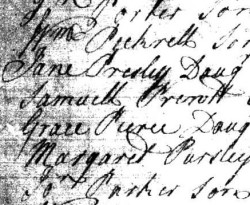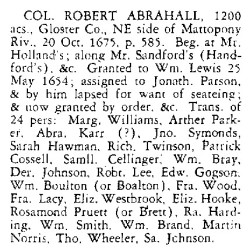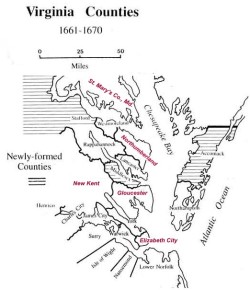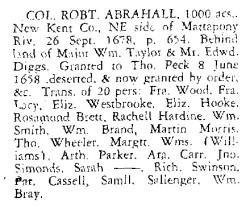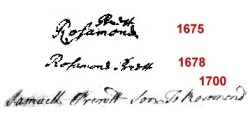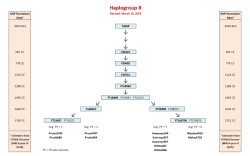The Swenys/Sweeneys/Swinneys
Part 1
Introduction
Why are we including the Swenys in this history of the Pruietts, Parkers and associated families? It all started in 2014 when Sweeneys, Swinneys and Whites started appearing in the Y-DNA matches for our line of Pruitts on Family Tree DNA. Within a couple of years, as more matches were added, it was apparent that they portended something more than just a few non-parental events (NPE) that happened a long time ago. It is now certain that the Pruitts are descended from a Sweny or Swaine who came to America in the 17th century. During the last few years, we have made progress in identifying a potential patriach for our Pruitts. This section is devoted to documenting the research that is going into this analysis. We still have much more work to do, but we are hopeful that, as more records are found, we will nail down the patriarch of our Pruiett line.
Rosamond Prewtt/Prentt/Pruett/Brett - Who Was She?
On February 1, 1700, Samuell Prewtt (or Prentt) was born to Rosamond according to Northumberland Co., Va. records. Beverley Fleet originally transcribed these St. Stephen's Parish birth records in 1938 and noted:
When the early records of Northumberland County were brought to the Department of Archives, in the Virginia State Library, in Richmond, most of them in sad condition, there appeared this worn and disordered book, marked St. Stephen's Parish. The entries date from 1661, long before there was a St. Stephen's Parish. Those from the beginning [1661] to the middle of the 18th century, a period of over ninety years, are all in the same handwriting.... We would assume that the book was made up from other records, now long lost.
How accurate are these records? How many errors or ambiguities were introduced in the rewrite? For our purposes, looking at the Rosamond Prewtt record, the most obvious question is whether the fourth letter of the last name is w or n? It looks like the n in many other records, but several lines down from Rosamond's record, we find someone named "Thos. Pew" and the w in this case looks just like the w in Prewtt. Perhaps the answer was more obvious in the original record but, given the widespread illiteracy of the times, it may not be all that important. Often, those documenting events wrote names phonetically. Pruitt is a good example given all the ways it has been written over the centuries within the same families. Even the name Pew was likely a phonetic spelling of Pugh, a name that appears often in later Northumberland Co. records.
Twenty-five years before this birth record, on October 20, 1675, a Rosamond Pruett (or Brett) was claimed as a headright (along with 24 other individuals) on a grant of 1200 acres in Gloucester Co., Va. to Col. Robert Abrahall. Three years later, on September 26, 1678, Rosamond Brett was (again?) claimed by Col. Abrahall as a headright (along with 19 other individuals) for an additional 1000 acres in New Kent Co., Va. Both properties were described as being on the "NE side of Mattopony Riv." Since New Kent and Gloucester were contiguous counties at this time, the properties were likely close to each other. The fact that Col. Abrahall claimed at least 19 of the same people for both of these land patents supports our belief that the two land-patent Rosamonds were the same person.
Each individual (or headright) entitled the patentee to 50 acres of land. It was common practice to buy and sell the names of potential headrights. The patentee need not have been responsible for paying the person's passage to America as long as he/she held the right to use their name. Each person's name should not have been used more than one time, but that requirement was often overlooked or ignored by patentees and the authorities who oversaw the process. In this case, since the land was patented in two different counties, the authorities may not have known that the colonel was using the same names.
The similarities of the names on the birth record and the two patents suggest that all three Rosamonds were the same person. Prewtt, Prentt, Pruett and Brett were the last names deciphered from the handwritten records by those transcribing them. Rosamond was not a common name and the spellings of the last names, while not always easy to determine, are not too different from each other. Since Col. Abrahall used many names more than once on his patents, it's likely he used the same Rosamond on these two patents. The Rosamond who gave birth to Samuell in Northumberland Co., Va. lived only about 30 to 40 miles from Gloucester County and New Kent County where Col. Abrahall patented his land.
It's very easy to imagine that Col. Abrahall could have bought Rosamond's headright soon after she arrived in America. Her arrival could have been in 1675 or a few years earlier. The colonel and Rosamond need never have met for him to secure her headright. It's also possible to assume that Rosamond was a child when she came to America and was still young enough to have a child in 1700 since there were no restrictions on the age of a headright.
So, who was Rosamond Prewtt? It's very likely she was a young English girl who emigrated to the American colonies in the early 1670s, willingly or not. Perhaps her parents died before she left England or on the voyage to Virginia and she was all alone in the colony. She likely lived in the Northern Neck area for years, perhaps working as a house servant when she was young and in the fields as she got older. Or she could have served a merchant in a town near the coast. We suspect she lived close to a shipping town and we presume, based on the next chapter of her life, she met someone and began a relationship that resulted in the birth of a son.
Was Our Samuel Pruitt the Son of Rosamond Prewtt?
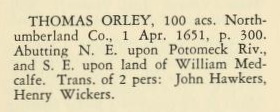
Was Rosamond Prewtt's son the Samuel Pruitt who lived in Maryland and fathered three sons who migrated to the Halifax/Pittsylvania Co., Va. area by the mid-1760s? Based on research in both Northumberland Co., Va. and Prince George's Co., Md., we are confident in concluding that Samuel Prewtt and Samuel Pruitt were the same individual. One path of migration was to cross the Potomac River into St. Mary's Co., Md. John Hawker/Hocker, who was likely the headright mentioned in this 1651 Northumberland County patent, and the grandfather of Samuel Pruitt's future wife, Elizabeth Hawker, took that route into Maryland many years earlier. Another route entailed taking a boat up the Potomac River to Charles Co., Md. and other counties in both Maryland and Virginia. We believe that Rosamond and her son took the Potomac River route to Prince George's Co., Md. where Samuel Pruitt met and married Elizabeth Hawker. See Pruiett, Part 1 for more on the research that helped us reach this conclusion.
Was Samuel Pruitt's Father a Sweny/Sweeney/Swinney/Swaine?
As explained above and in Pruiett, Part 1, it's clear that Rosamond Prewtt was a single mother to Samuel Pruitt. Is there any way to determine Samuel's father? Let's look at thirteen individuals who are related within the genealogical timeframe to see how their Y-DNA markers might suggest relationships between them and where Samuel Pruitt might fit in that picture.
The thirteen testers listed in the above chart took the FTDNA 111-marker Y-DNA test. All thirteen testers had identical values for 93 of the 111 markers. Listed above are the 18 markers that had a difference in one or more testers. Using this author (Pruiett742) as the baseline, we can determine the number of marker differences between him and each of the testers. Those differences, called Genetic Distance by FTDNA, are a crude way to identify how many generations there are between two testers. For Pruitt688, the number of marker differences is 4 (DYS712 is not highlighted because it is one of the fastest mutating markers and, for this group, has such a wide variation in results). If we then look at the documented family trees of Pruiett742 and Pruitt688, we see that they are in fact separated by four generations to their most recent common ancestor (MRCA) who happens to be Thomas Stuart Pruitt, born in 1814. For Pruitt304 and Pruett767, the marker differences with Pruiett742 are 4 and 5 respectively. Based on their family trees compared to Pruiett742, they are actually separated by 8 generations, having Samuel Pruitt, born around 1700, as their MRCA. The results of this kind of analysis are not always perfect, but the trend is usually pretty clear. All the Whites, Sweeneys/Swinneys and the Blaylocks are 5 to 7 generations removed from Pruiett742 according to their Y-DNA tests, suggesting that they may share a MRCA born around 1700 or a generation or two before that. Since Samuel Pruitt's descendants are well documented in historical records, this analysis seems correct. It would be impossible to construct a theory that the common ancestor of these thirteen testers was born after Samuel Pruitt.
The boxed markers in the above chart identify markers that may demonstrate where some of our testers broke off from the others. The DYS464a value of 14 and the DYS452 value of 31 are unique to all four Pruitts. This mutation likely occurred at the time Samuel Pruitt was born in 1700 or a generation earlier, but before the Samuel Pruitt line separated into two distinct lines in the 1730s. Another marker, DYS537, probably mutated to 11 after the split from Pruitt304 and Pruett767, but before their split from each other around 1860, since Pruitt304 and Pruett767 still retain the original value of 10 that they share with all the non-Pruitt testers. In the same way, the result of 15 in DYS389i may represent a split in the Sweeneys and the result of 15 in DYF395S1a may represent a split in the Whites. Since we don't have definitive pre-19th century genealogies for the Sweeneys and Whites, these mutations may be useful in fleshing out those genealogies as more information comes to light. The fact that Blalock702 shares the mutation of 15 in DYS389i with the two Sweeneys may be helpful in determining when the Blaylocks split from the other testers, but the fact that Blaylock416 retains the value of 14 complicates the analysis. Since STRs can mutate forward and backward, we can never be sure that analyzing one particular marker's changes can be definitive in researching family trees. We can only use those changes that occur in two or more individuals as a possible indicator of a genetic split in a family line. Only historical research can prove the case.
Who was the common ancestor of our thirteen testers? We are confident that the four Whites in our test group are descended from Moses Swinney, born before 1717. Based on deed and land records, we know he lived in Edgecombe Co., N.C. as early as 1738 and then appears to have died in Granville Co., N.C. in 1754 based on estate records recorded that year. Granville County was formed out of Edgecombe County in 1746, so it's possible that Moses Swinney didn't actually move from one county to the other. At least two of his sons, Littleberry and Cajabeth, took their stepfather's surname of White. We are very confident that all of the White testers descend from two or more of Moses Swinney's sons who took the White surname. Based on this, we know the Whites are really Swinneys and likely descend from the same ancestor as our Sweeney/Swinney testers. Does this mean that Samuel Pruitt also descends from a common ancestor with the Sweeneys and Whites? The short answer is yes. SNP testing performed through FTDNA's Big Y test confirms that our eleven testers who have taken the Big Y are descended from a relatively recent common ancestor based on the fact that they share the SNP FT18699 (and its equivalents - FT19047 and FT21223), the earliest of which formed around 1495 CE. The SNPs that represent the beginning of the Sweeney/White/Blaylock line and the Pruitt line (i.e., FT55898 and Y168267) formed around 1634 CE and 1664 CE respectively. These years of SNP formation were calculated by Family Tree DNA's Discover program and are "based on SNP and STR test results from many present-day DNA testers." Thus, the split between the Sweeneys/Whites/Blaylocks and the Pruitts likely occurred in the mid to late 1600s based on these calculations. With more Big Y tests, we may see more refinements in the dates of SNP formation which will help us more precisely pinpoint the time period for the birth of the common ancestor for these family lines.
